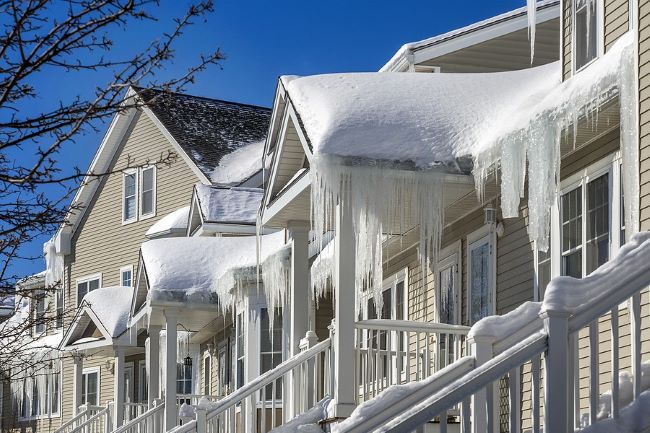Preventing Property Damage Caused by Ice Dams

Allowing ice dams to form on your roof can lead to major structural damage. Learn the signs of ice dams and steps to take to help prevent this winter hazard.
Ice Dams vs. Icicles
Icicles form when dripping water freezes. They’re often present on the gutters and eaves of buildings. Ice dams, on the other hand, form on the roofs of buildings, typically near the edge. You can have icicles without ice dams and ice dams without icicles. However, as Michigan’s MIREADY program warns, significant icicles on your gutter or eaves could indicate the presence of an ice dam.
Both icicles and ice dams can damage your roof, but ice dams are especially hazardous. Ice dams form when snow melts and then refreezes on your roof. The melted water may find its way under the shingles before it refreezes – and water expands when it freezes. Plus, ice dams trap water on your roof, causing it to pool. For these reasons, ice dams can lead to roof leaks, mold, and rot.
Insulation and Ventilation Are Key
Ice dams can’t form unless snow melts and then refreezes. Proper insulation and ventilation can prevent this cycle. Although a warm roof might sound ideal, it’s actually a problem because the outside air is still cold. In fact, having different temperatures is what causes the cycle of melting and refreezing. By keeping your roof cool, you can help prevent snow from melting.
According to a guide from Wisconsin’s Focus on Energy program, the best way to prevent ice dams is to improve the insulation in your attic. Places like attic hatches, heating ducts, and vent stacks act as attic bypasses, allowing warm air from the rest of your home or building to enter your attic. You may be unable to identify problem areas on their own, but professionals have equipment to help you locate and seal these leaks. The easiest time to address air leaks is during the initial construction of the building, but you can also tackle this issue when you’re repairing or replacing your roof.
Your roof’s R-Value indicates its insulation level, with a higher value meaning the insulation is better. The National Weather Service says experts typically recommend a minimum of R-30, although a value of at least R-38 is preferable in northern climates. It’s also important to have good airflow under the eaves and through the roof vents.
Proper Maintenance Can Help
Proper maintenance can also help prevent ice dams.
The National Weather Service says you should clear leaves and other debris from your gutters and downspouts. Throughout the winter, you should also keep gutters and downspouts free of snow, icicles, and debris. This allows melting snow to drain properly, preventing it from pooling on your roof and then refreezing.
The National Weather Service also recommends keeping the snow on your roof to a minimum. It may be possible to use a long-handled roof rake to remove snow from the roof while remaining on the ground – as long as you’re careful and aware of potential risks.
Although removing snow from ground level is safe when you use the proper tools and techniques, removing ice can be dangerous. When icicles and ice dams break off, they can cause damage and injure anyone in their way. For this reason, you should only use professional ice removal services.
Watch for Warning Signs
When you know what to look for, you can spot ice dams and take action to mitigate the damage.
Watch for icicles. Icicles and ice dams often occur together.
Compare your roof to your neighbor’s. If your neighbor’s roof is still covered in snow, but the snow has mostly melted on yours and icicles have formed, your roof may lack the insulation it needs to prevent ice dams.
Look for signs of water damage. Since ice dams often cause leaks, be alert for signs of water damage. This could include water stains, mold, or mildew on the ceiling and walls of your house. Damage to the paint on your home’s siding can also be an indication of water damage.
Property insurance often includes coverage for damage from ice dams. If you have questions about your insurance needs, contact BNC.




